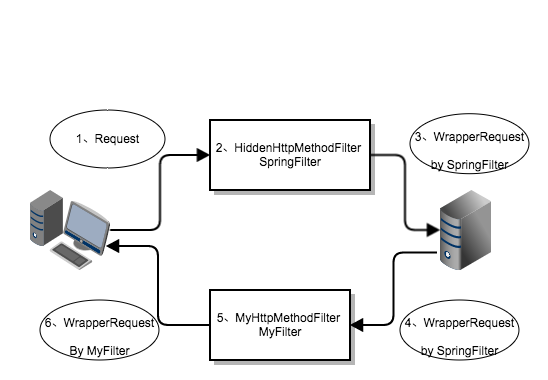Spring MVC 學習筆記(二):@RequestMapping用法詳解
一、@RequestMapping 簡介
在Spring MVC 中使用 @RequestMapping 來對映請求,也就是通過它來指定控制器可以處理哪些URL請求,相當於Servlet中在web.xml中配置
<servlet>
<servlet-name>servletName</servlet-name>
<servlet-class>ServletClass</servlet-class>
</servlet 的對映作用一致。讓我們先看一下RequestMapping註解類的原始碼:
@Target({ElementType.METHOD, ElementType.TYPE})
@Retention 1)在@Target中有兩個屬性,分別為 ElementType.METHOD 和 ElementType.TYPE ,也就是說 @RequestMapping 可以在方法和類的宣告中使用
2)可以看到註解中的屬性除了 name() 返回的字串,其它的方法均返回陣列,也就是可以定義多個屬性值,例如 value() 和 path() 都可以同時定義多個字串值來接收多個URL請求
二、準備工作:(注:後面的示例都將基於準備工作)
1)新建一個 Web 工程,取名為 SpringMVC
略
2)新建一個的控制器類:UserController
package cn.kolbe.spring.mvc.controller;
import org.springframework.stereotype.Controller;
@Controller
public class UserController {
public String login() {
return "success";
}
}3)新建和配置 web.xml 以及 spring-mvc.xml 檔案
略(具體參見 前一章:Spring MVC 學習筆記(一):HelloWorld)
4)新建一個測試的 JSP 頁面 index.jsp
<%@ page language="java" contentType="text/html; charset=UTF-8" pageEncoding="UTF-8"%>
<!DOCTYPE html>
<html>
<head>
<meta charset="UTF-8">
<title>Spring MVC</title>
</head>
<body>
<p> <a href="#">User Login</a>
</body>
</html>5)新建一個成功跳轉的頁面 JSP 頁面 welcome.jsp
<%@ page language="java" contentType="text/html; charset=UTF-8" pageEncoding="UTF-8"%>
<!DOCTYPE html>
<html>
<head>
<meta charset="UTF-8">
<title>Spring MVC</title>
</head>
<body>
<h1>Welcome</h1>
</body>
</html>三、測試 @RequestMapping 中的 value 和 path 屬性(這兩個屬性作用相同,可以互換,如果僅有這一個屬性,則可以省略,下面兩個例子均採用省略的方式)
1)將 @RequestMapping 註解在 login 方法上,而UserController上不新增 @RequestMapping 註解,這時的請求 URL 是相對於 Web 根目錄
@Controller
public class UserController {
@RequestMapping("/login")
public String login() {
return "success";
}
}這時的方法 login() 能處理的 URL 請求路徑是基於 Web 應用的,也就是 http://localhost/SpringMVC/login,也就是 index.jsp 頁面中的 User Login 連結地址應該是:
<a href="login">User Login</a>2)將 @RequestMapping 註解在 UserController 類上,這時類的註解是相對於 Web 根目錄,而方法上的是相對於類上的路徑
@Controller
@RequestMapping("/user")
public class UserController {
@RequestMapping("/login")
public String login() {
return "success";
}
}這時的方法login()能處理的 URL 請求路徑則是 http://localhost/SpringMVC/user/login,也就是 index.jsp 頁面中的 User Login 連結地址應該是:
<a href="user/login">User Login</a>四、測試 @RequestMapping 的 method 屬性
1)簡介:@RequestMapping 中的 method 主要用來定義接收瀏覽器發來的何種請求。在Spring中,使用列舉類
org.springframework.web.bind.annotation.RequestMethod來定義瀏覽器請求的方式。
Http規範定義了多種請求資源的方式,最基本的有四種,分別為:GET(查)、POST(增)、PUT(改)、DELETE(刪),而URL則用於定位網路上的資源相當於地址的作用,配合四種請求方式,可以實現對URL對應的資源的增刪改查操作。
在實際應用中,很多人並沒有按照這個規範做,因為使用GET/POST同樣可以完成PUT和DELETE操作,甚至GET也可以完成POST操作,因為GET不需要用到表單,而POST卻需要通過表單來發送。
2)通過 @RequestMapping(value="/login",method=RequestMethod.GET) 來指定 login()方法 僅處理通過 GET 方式發來的請求
@Controller
@RequestMapping(path = "/user")
public class UserController {
@RequestMapping(path = "/login", method=RequestMethod.GET)
public String login() {
return "success";
}
}這時,如果瀏覽器發來的請求不是GET的話,將收到瀏覽器返回的錯誤提示,也就是得通過連結的方式而不是表單的方式:
<a href="user/login>User Login</a>3)通過 @RequestMapping(value="/login",method=RequestMethod.POST) 來指定 login()方法 僅處理通過 POST 方式發來的請求
@Controller
@RequestMapping(path = "/user")
public class UserController {
@RequestMapping(path = "/login", method=RequestMethod.POST)
public String login() {
return "success";
}
}這時,必須通過表單的方式傳送請求,否則將收到瀏覽器返回的錯誤提示
<form action="user/login" method="post">
<input type="submit" value="使用Post傳送請求"/>
</form>4)由於在 RequestMapping 註解類中 method() 方法返回的是 RequestMethod 陣列,所以可以給 method 同時指定多個請求方式,例如:
@Controller
@RequestMapping(path = "/user")
public class UserController {
// 該方法將同時接收通過GET和POST方式發來的請求
@RequestMapping(path = "/login", method={RequestMethod.POST,RequestMethod.GET})
public String login() {
return "success";
}
}五、測試 @RequestMapping 的 params 屬性,該屬性表示請求引數,也就是追加在URL上的鍵值對,多個請求引數以&隔開,例如:
http://localhost/SpringMVC/user/login?username=kolbe&password=123456則這個請求的引數為username=kolbe以及password=123456,@RequestMapping 中可以使用 params 來限制請求引數,來實現進一步的過濾請求,舉個例子:
@Controller
@RequestMapping(path = "/user")
public class UserController {
// 該方法將接收 /user/login 發來的請求,且請求引數必須為 username=kolbe&password=123456
@RequestMapping(path = "/login", params={"username=kolbe","password=123456"})
public String login() {
return "success";
}
}該例中則表示 UserController 中的 login() 方法僅處理 /user/login 發來的請求,且必須帶有 username=kolbe&password=123456 的請求引數,否則瀏覽器將返回HTTP 404的錯誤, 對應 index.jsp 中的鍵接地址為:
<a href="user/login?username=kolbe&password=123456">User Login</a>六、測試 @RequestMapping 的 headers 屬性,該屬性表示請求頭
用於HTTP協義互動的資訊被稱為HTTP報文,客戶端傳送的HTTP報文被稱為請求報文,伺服器發回給客戶端的HTTP報文稱為響應報文,報文由報文頭部和報文體組成。
請求頭部(Request Headers):請求頭包含許多有關客戶端環境和請求正文的資訊,例如瀏覽器支援的語言、請求的伺服器地址、客戶端的作業系統等。
響應頭部(Rsponse Headers):響應頭也包含許多有用的資訊,包括伺服器型別、日期、響應內容的型別及編碼,響應內容的長度等等。
如果你安裝的是Chrome瀏覽器,可以通過在網頁中 右擊滑鼠---->審查元素---->Network---->Name中點選網頁---->右側檢視Headers即可,如果Name中沒有出現網頁,可以重新整理一下即可,下邊是我電腦中的一個請求頭部示例:
Request Headers
Accept:text/html,application/xhtml+xml,application/xml;q=0.9,image/webp,*/*;q=0.8
Accept-Encoding:gzip, deflate, sdch
Accept-Language:zh-CN,zh;q=0.8
Cache-Control:max-age=0
Connection:keep-alive
Cookie:JSESSIONID=210075B5E521CWE3CDE938076295A57A
Host:localhost:8080
Upgrade-Insecure-Requests:1
User-Agent:Mozilla/5.0 (Macintosh; Intel Mac OS X 10_9_5) AppleWebKit/537.36 (KHTML, like Gecko) Chrome/45.0.2454.93回規正題,通過 @RequestMapping 中的 headers 屬性,可以限制客戶端發來的請求
@Controller
@RequestMapping(path = "/user")
public class UserController {
// 表示只接收本機發來的請求
@RequestMapping(path = "/login", headers="Host=localhost:8080")
public String login() {
return "success";
}
}七、帶佔位符的URL
(一)帶佔位符的URL是Spring 3.0 新增的功能,可以通過 @PathVariable 將 URL 中的佔位符繫結到控制器的處理方法的引數中,佔位符使用{}括起來
(二)使用方法:
1)帶佔位符的URL示例:
@Controller
@RequestMapping(path = "/user")
public class UserController {
@RequestMapping(value="/{id}", method=RequestMethod.GET)
public String show(@PathVariable("id") Integer id) {
return "success";
}
}在這個控制器中 show() 方法將可以接收 user/1、user/2、user/3等等的路徑請求,請求的方法必須為GET,使用 @PathVariable 為應用實現 REST 規範提供了具大的便利條件。
八、採用 REST 風格的 URL 請求
1)簡介:REST(Representational State Transfer):(資源)表現層狀態轉化,它是目前最流行的一種軟體架構,其結構清晰、易於理解、擴充套件方便且符合標準,正在越來越多的被實踐到應用中。
2)REST 風格的 URL 請求
請求路徑 請求方法 作用
-/user/1 HTTP GET 得到id為1的user
-/user/1 HTTP DELETE 刪除id為1的user
-/user/1 HTTP PUT 更新id為1的user
-/user HTTP POST 新增user3)由於瀏覽器表單只支援 GET 和 POST 請求,為了實現 DELETE 和 PUT 請求,Spring 為我們提供了一個過濾器org.springframework.web.filter.HiddenHttpMethodFilter,可以為我們將 GET 和 POST 請求通過過濾器轉化成 DELETE 和 PUT 請求。
4)在 web.xml 中配置過濾器
<!-- 配置 org.springframework.web.filter.HiddenHttpMethodFilter 過濾器 -->
<filter>
<filter-name>hiddenHttpMethodFilter</filter-name>
<filter-class>org.springframework.web.filter.HiddenHttpMethodFilter</filter-class>
</filter>
<filter-mapping>
<filter-name>hiddenHttpMethodFilter</filter-name>
<!-- 攔截所有請求 -->
<url-pattern>/*</url-pattern>
</filter-mapping>5)由於瀏覽器表單無法傳送 DELETE 和 PUT 請求,所以為了讓 HiddenHttpMethodFilter 識別請求的方法,需要在表單中新增一個隱藏域,名字為 _method 值為 DELETE 或 POST 或PUT,修改後 index.jsp 頁面程式碼如下:
<%@ page language="java" contentType="text/html; charset=UTF-8" pageEncoding="UTF-8"%>
<!DOCTYPE html>
<html>
<head>
<meta charset="UTF-8">
<title>Spring MVC</title>
</head>
<body>
<p>
<!-- 得到id為1的user -->
<a href="user/1">Test Rest GET</a>
<!-- 新建id為1的user -->
<form action="user" method="post">
<input type="hidden" name="_method" value="POST"/>
<input type="submit" value="Test Rest POST"/>
</form>
<!-- 刪除id為1的user -->
<form action="user/1" method="post">
<input type="hidden" name="_method" value="DELETE"/>
<input type="submit" value="Test Rest DELETE"/>
</form>
<!-- 更新id為1的user -->
<form action="user/1" method="post">
<input type="hidden" name="_method" value="PUT"/>
<input type="submit" value="Test Rest PUT"/>
</form>
</body>
</html>6)修改後的UserController程式碼
package cn.kolbe.spring.mvc.controller;
import org.springframework.stereotype.Controller;
import org.springframework.web.bind.annotation.PathVariable;
import org.springframework.web.bind.annotation.RequestMapping;
import org.springframework.web.bind.annotation.RequestMethod;
@Controller
@RequestMapping(path = "/user")
public class UserController {
@RequestMapping(value="/{id}", method=RequestMethod.GET)
public String show(@PathVariable("id") Integer id) {
System.out.println("檢視id為:" + id + "的user");
return "success";
}
@RequestMapping(value="/{id}", method=RequestMethod.PUT)
public String update(@PathVariable("id") Integer id) {
System.out.println("更新id為:" + id + "的user");
return "success";
}
@RequestMapping(value="/{id}", method=RequestMethod.DELETE)
public String destroy(@PathVariable("id") Integer id) {
System.out.println("刪除id為:" + id + "的user");
return "success";
}
@RequestMapping(value="", method=RequestMethod.POST)
public String create() {
System.out.println("新建user");
return "success";
}
}注:如果你的web專案是執行在Tomcat 8下,你會發現被過濾成DELETE和PUT請求,到達控制器後,返回時(forward)會報HTTP 405的錯誤提示
HTTP Status 405 - Request method 'DELETE' not supported
或
HTTP Status 405 - JSPs only permit GET POST or HEAD有三種解決方案:
(一)將 Tomcat 8 改為 Tomcat 7,在Tomcat 7 下執行是正常的
(二)將請求轉發(forward)改為請求重定向(redirect)
(三)自己手動寫一個Filter來包裝HttpRequest中的getMethod()方法
下面介紹一下第(三)種做法,也就是自己寫一個Filter來包裝從伺服器發回來的HttpRequest請求:

大致說一下流程,
1. 在第1步中,客戶端傳送請求至伺服器,這時如果傳送的是POST請求且帶有以_method為名的引數會被Spring的HiddenHttpMethodFilter給攔截。
2. HiddenHttpMethodFilter內有一個靜態內部類通過繼承HttpServletRequestWrapper類並重寫getMethod()方法,將該方法返回值設為_method隱藏域的值。
3. HiddenHttpMethodFilter在包裝好Request後,將請求發往伺服器的控制器中對應的方法處理器,這時的請求變成了圖中的 3、WrapperRequest by SpringFilter
4. 伺服器處理完請求後,產生了一個forward請求,產生相應的請求處理資訊發往客戶端,注意這時的request的getMethod()方法仍然是HiddenHttpMethodFilter包裝過的
5. 我們需要在伺服器的響應請求到達客戶端前進行攔截,這也是最關鍵的一步,通過自定義過濾器MyHttpMethodFilter進一步包裝請求,將getMethod()方法返回值改成POST或GET即可
6. 在web.xml中配置該filter,注意dispatcher結點值必須為FORWARD。由於字數超限,暫時說到這。。。
<filter-mapping>
<filter-name>myFilter</filter-name>
<url-pattern>/*</url-pattern>
<dispatcher>FORWARD</dispatcher>
</filter-mapping>- 分類:Spring
- 字數:2842
